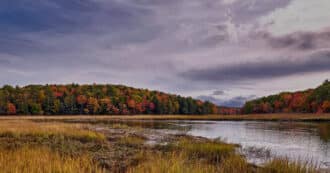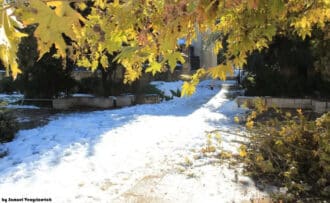By Harry Cooper – The Arctic National Wildlife Refuge, often shortened to ANWR, is a massive wildlife refuge in northeast Alaska. The ANWR is the largest national wildlife refuge in the United States, and is about the size of South Carolina. With around 19 million acres of federally protected land, the arctic refuge is home to many different species of mammals, fish, and birds, and facilitates a massive arctic ecosystem.
Protecting the North
While the refuge system is considered one of the greatest natural treasures in America, the ANWR has recently come under threat. Oil and gas companies are seeking to undergo major oil and gas development along the northern arctic ocean coast, as many fossil fuel deposits have been found in the coastal plains region of the ANWR.
This oil and gas drilling would devastate the natural ecosystems in the refuge. Activists everywhere are advocating to keep the ANWR protected from human influence, as such a large natural space is so environmentally valuable in a world rapidly losing its wilderness.
The History of The Arctic National Wildlife Refuge
The land of the Arctic National Wildlife Refuge has historically been used by indigenous communities for tens of thousands of years for caribou hunting. However, it was not until more recent history that the land became protected under the US federal government.
The ANWR was first established in 1960 after pressure from conservationist movements at the time. Initially the park was only 8.9 millions acres but later the protected refuge was expanded to the size it is today.
The Ecology of the Arctic National Wildlife Refuge
As the name suggests, the Arctic National Wildlife Refuge is home to many different kinds of wildlife. The massive area is capable of supporting a large diverse ecosystem with a wide variety of species.
Caribou
The ANWR is incredibly important for maintaining caribou populations. One of the world’s largest caribou herds, the porcupine caribou herd, uses the ANWR as annual calving grounds. By leaving the wildlife refuge untouched by human influence, this caribou herd with almost 200,000 caribou is able to have a consistent natural wilderness space to help raise their young.
Migratory Birds
The Arctic National Wildlife Refuge also plays an important role in hundreds of different bird migrations. Birds from six different continents all come to the ANWR to nest and raise their young. The long days of the Arctic summer facilitate an unusually high amount of bugs and plants for the Arctic, making the region of the ANWR ideal for bird migration. With such a large number of birds using the ANWR for a critical stage in their migratory life cycle, the ANWR has earned the nickname of the world’s bird nursery.
Polar Bears
Polar bears are a species that is becoming increasingly threatened with extinction, and the Arctic National Wildlife Refuge has become one of the most critical polar bear habitats in the world. As polar bears become more and more vulnerable to human influence the ANWR provides a protected safe haven. It is estimated that around 43% of all polar bear land dens in Alaska are located in the ANWR. These dens are used by mothers to birth and raise their cubs. Thus the the protection provided by the ANWR plays an important role in helping polar bears resist extinction.
Other Wildlife
Along with caribou, migratory birds, and polar bears there are also many other animals that call the ANWR home. The ANWR provides protection to 42 different fish species, 39 different types of land mammal, seven marine mammals, and over 200 different birds. This makes the ANWR an incredibly important and biodiverse place for protecting all kinds of arctic life.
Recreation
While there are no roads or trails within the Arctic National Wildlife Refuge, there are still several recreational activities allowed for humans within the ANWR. Most visitors will find themselves having to be taken to the park via plane or guided tour. Many outdoor activities are allowed in the refuge such as hiking, fishing, rafting, wildlife viewing, etc. While the ANWR is incredibly remote, visiting such a pristine and grand piece of wilderness can be a great way for visitors to experience a very raw form of natural environment.
Threats to the Arctic National Wildlife Refuge
The ANWR constitutes a great asset to hundreds of different animals. But recently the ANWR’s protection status has been threatened.
Oil in the Arctic Refuge Coastal Plain
Along the northern part of the ANWR lies the arctic refuge’s coastal plain. This region is not only essential for wildlife, but it is also one of the largest oil reserves in the US. It is estimated that there is anywhere from 4.3 to 11.8 billion barrels of oil available for extraction in the costal plains region of the ANWR. While these oil reserves present a major opportunity for oil and gas drilling, it means devastating the pristine wildlife there.
Politics
In 2017, congress added a policy onto the Tax Cuts and Jobs Act that would lease land in the vulnerable coastal plains region to major oil companies for drilling. The current administration has since paused the oil and gas drilling developments until further environmental impact reports have been filed, but the region is still under threat from those who seek to drill there. Since Russian oil and gas is becoming an unattractive option since their invasion of Ukraine, we can not predict what the impact will be on the ANWR.
It is already known that the impact of this drilling would be huge. The once completely untouched piece of land would be filled with development, roads, noise, pollution, and heavy machinery. This kind of oil and gas development would threaten the species and migration patterns that the ANWR stands to protect, undermining the entire purpose of the refuge.
Religion and the ANWR
Courtney Blackmer-Raynolds wrote for Colorado College about the ANWR, the native people who live there, and how they are threatened by oil drilling. The native Gwich’in people call ANWR “the sacred place where life begins,” and their identity is deeply tied to the land and the wild herbs of caribou that live there. In fact, the word “Gwich’in,” means “the caribou people.” But why are they so connected to the caribou?
For the Gwich’in, caribou are “their currency and their main source of sustenance… The caribou provide meat, furs and leather for clothing and construction, and bone for tools. These herd animals provide not only subsistence for the Gwich’in, but they also create a cultural and spiritual grounding for the people.” The Gwich’in live in sync with the land and her animals, viewing them as sacred and worthy of the highest respect.
Oil drilling threatens to pollute the Gwich’in’s land and deplete their caribou, by some studies by as much as 40%. Blackmer-Raynolds explains how according to one tribal activist, “the environmental degradation caused by oil drilling would be like a ‘cultural genocide’ for the Gwich’in people.” To live with environmental degradation and the loss of the caribou would be no better than exiling the Gwich’in people, because they would lose the pristine land and animals of their ancestors that defines their identity.
We must protect the Artic National Wildlife Refuge for the sake of the land and her protectors, the Gwich’in people. Different religions can feel tied to different lands. For example, Jews are connected to Israel, Muslims are connected to Mecca and Catholics are connected to the Vatican. With this awareness, we can respect the Gwich’in’s connection to their land in Northern Alaska, and support them in their struggle to protect the land and their way of life. In looking out for each other, we’ll find ourselves safer than we could ever be alone.
* Featured image source









